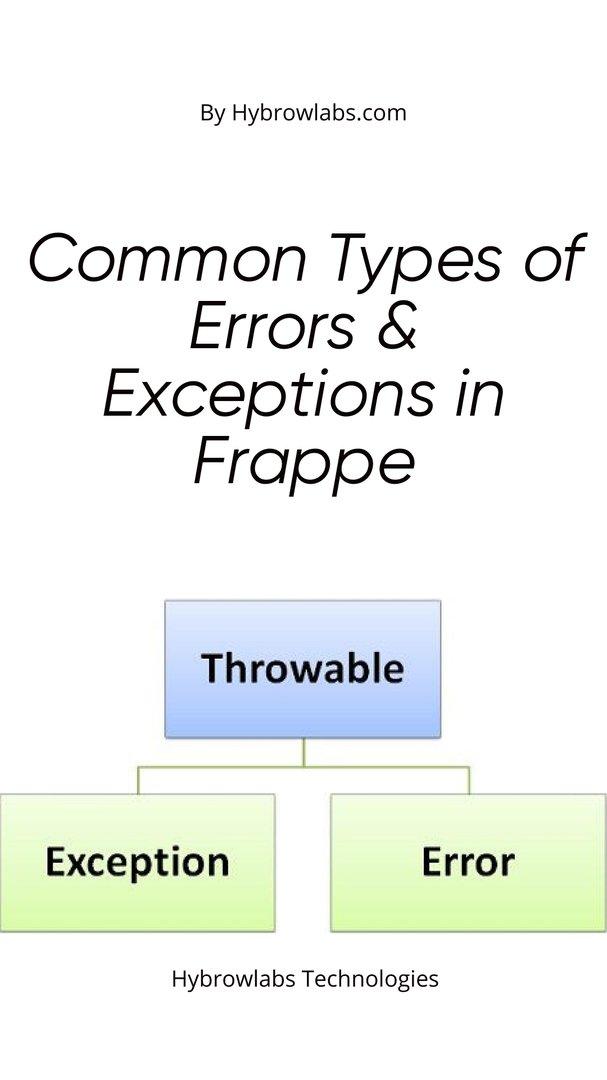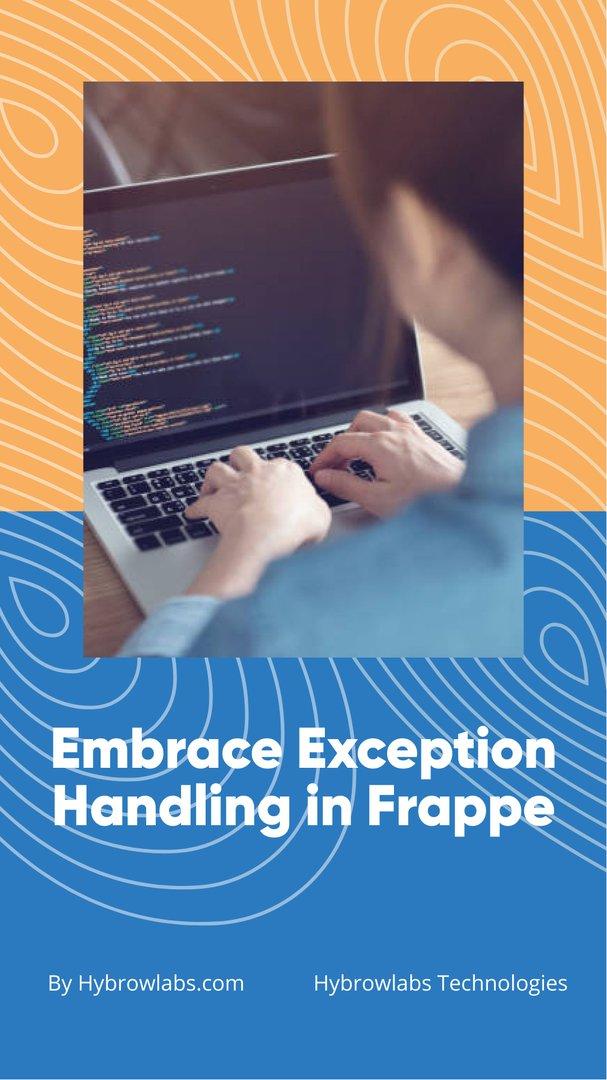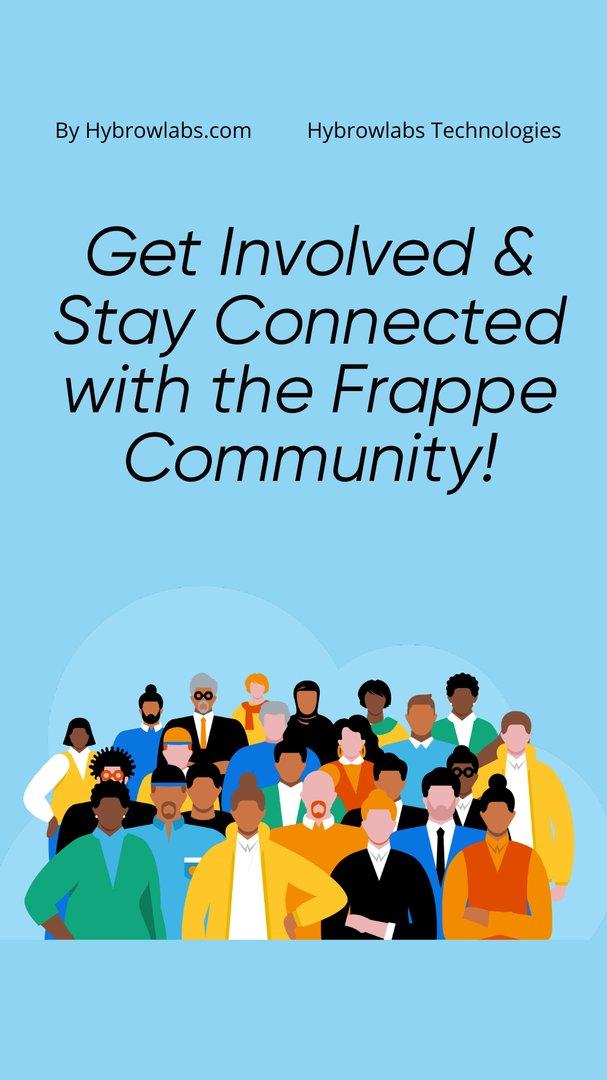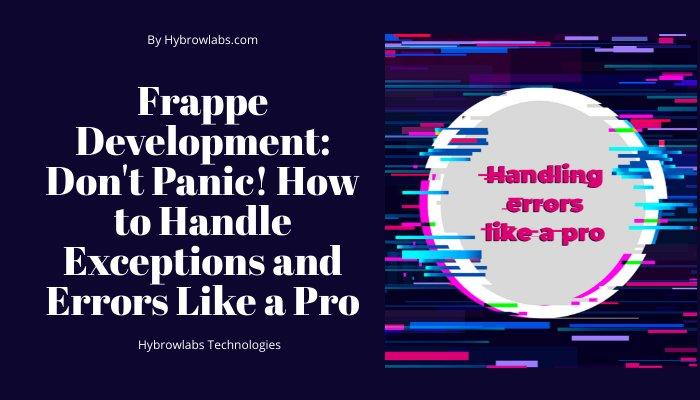What is Frappe's development and why is it important?
Frappe development is using the Frappe framework to build web applications. Frappe is a full-stack web application framework built on Python and JavaScript that provides features like form management, workflow, data import and export, and report generation.
It is important because it allows developers to create complex applications with minimal coding, reducing development time and costs. Frappe's modular architecture and built-in functionality make it easy to create custom workflows and automate business processes. The framework is highly flexible, allowing developers to create applications that are tailored to specific business needs.
An overview of exceptions and errors in Frappe development: what they are and why they matter?
Exceptions and faults frequently occur when developing Frappe. An exception is a condition that prevents a program from running normally and is typically brought on by unexpected or incorrect input. On the other hand, an error occurs when the program does not run as intended for a variety of reasons, such as a system or network failure.
Errors and exceptions in Frappe development might happen for a variety of causes, including bad user input, server outages, or programming problems. The application may freeze, crash, or produce inaccurate results as a result of these problems, which could hurt the user experience.
Why handling exceptions and errors is crucial in Frappe's development?
The stability, dependability, and security of the web application are all ensured by handling exceptions and mistakes during Frappe development. Exceptions and errors can happen for a number of reasons, such as incorrect user input, server outages, or programming problems. If ignored, these mistakes can result in data loss, system crashes, and security flaws.
Frappe developers may enhance user experience, avoid data loss, and boost application speed by handling exceptions and mistakes. Also, it aids in spotting and resolving possible concerns before they become serious ones. Try-except blocks, logging, and error messages are just a few of the methods and tools that Frappe offers for dealing with errors and exceptions. Building solid and dependable web apps requires proper handling of errors and exceptions.
Types of exceptions and errors in Frappe development:

In Frappe development, it's essential to handle exceptions and errors that can occur. Here are the common types of exceptions and errors and their explanations:
1.Key Error - Occurs when you try to access a dictionary key that doesn't exist. For instance, if you try to access a non-existent key in a dictionary, you'll get a Key Error.
Example:
person = {'name': 'John'}; print(person['age']).
2.Value Error - Occurs when a function or method receives an argument of the correct type but with an inappropriate value. For instance, if you try to convert an alphanumeric string to an integer using the int() function, you'll get a Value Error.
Example:
int('xyz')
3.Type Error - Occurs when an operation or function is applied to an object of inappropriate type. For instance, if you try to concatenate a string and an integer using the + operator, you'll get a Type Error.
Example:
'2' + 2
4.Attribute Error - Occurs when an object doesn't have a certain attribute. For instance, if you try to access a non-existent attribute of an object, you'll get an Attribute Error.
Example:
person = {'name': 'John'}; person.age
5.Syntax Error - Occurs when code is not written correctly and cannot be parsed. For instance, if you have an invalid syntax in your code, you'll get a Syntax Error.
Example:
if x = 5:
6.Import Error - Occurs when a module is not found or cannot be imported. For instance, if you try to import a non-existent module, you'll get an Import Error.
Example:
import non_existing_module.
7.Database Error - Occurs when there's an issue with the database, such as a connection problem, query error, or table doesn't exist. For instance, if you try to execute a non-existent query or access a non-existent table, you'll get a DatabaseError.
The most prevalent forms of faults and exceptions that can arise must be recognized by developers, and they must have plans in place to manage them successfully. It is essential to handle mistakes and exceptions correctly in order to maintain the application's dependability, security, and stability.
Common causes of exceptions and errors in Frappe development:
Throughout the development of Frappe, faults and exceptions might have a number of common sources. Among the most typical ones are:
- Server outage: A server outage occurs when the server hosting the Frappe application is down or unavailable. This can be due to issues such as maintenance, hardware failure, or network problems. When the server is down, users may experience exceptions and errors when trying to access the application.
- Network problems: Network problems such as poor connectivity or network congestion can cause exceptions and failures during Frappe development. These problems can be due to issues such as network misconfiguration, hardware failure, or software bugs.
- Inadequate resources: When the Frappe application doesn't have enough resources such as memory, CPU power, or storage to handle the workload, it can lead to exceptions and errors. This can be due to issues such as poor resource allocation, inefficient code, or unexpected spikes in user traffic.
- External dependencies: External dependencies such as third-party libraries or APIs can cause exceptions and errors in Frappe development. These issues can arise due to compatibility issues, version conflicts, or bugs in the external dependency.
To prevent these common causes of exceptions and errors, it's essential to conduct regular maintenance and testing, monitor system resources, handle errors and exceptions gracefully, and ensure compatibility and integration of external dependencies.
What are the best practices for effectively handling exceptions and errors in Frappe development?
1. Use of try-except blocks:
Using try-except blocks is one of the finest methods for handling exceptions. You can catch exceptions with try-except blocks and manage them in a way that keeps your program from crashing. You can recognize and elegantly handle any potential mistakes by putting the code that might cause an exception in a try block.
It's critical to handle exceptions in a way that not only reports the issue for troubleshooting but also gives the user useful feedback. Also, you want to refrain from capturing general exceptions in favor of those that are pertinent to the particular operation being carried out.
2. Proper logging and error reporting:
A vital component of Frappe development is proper logging and error reporting, which helps programmers in locating and resolving problems that may occur with the application. When an issue happens, it's crucial to record it in a way that includes details about the mistake's nature, location, and any pertinent context. The problem can then be diagnosed using this information, and the best way to fix it can then be decided.
In addition to reporting errors, it's crucial to give end users concise, helpful error messages. End users assist them in figuring out what went wrong and in taking the appropriate action to fix it.
3. Use of Frappe's built-in error-handling mechanisms:
Frappe provides several built error-handling mechanisms that developers can use to improve the robustness of their applications. These mechanisms include:
- The frappe. throw function - This function can be used to raise exceptions and display error messages to the user. It allows developers to customize the error message and provide helpful context to the user.
- The frappe.log_error function - This function is used to log errors to the server's error log. It provides detailed information about the error, including the stack trace, making it easier for developers to diagnose and resolve issues.
- The try_except decorator - This decorator can be used to automatically log errors and display user-friendly error messages. It simplifies error handling by allowing developers to focus on the core logic of their code.
By utilizing these built-in error-handling mechanisms, developers can improve the stability and reliability of their Frappe applications. They can ensure that errors are properly logged and displayed to the user, allowing for quicker diagnosis and resolution of issues.
Advanced Techniques for Handling Exceptions and Errors in Frappe Development:

1. Custom error handling and reporting:
Developers can add their own unique error-handling and reporting strategies to their applications in addition to the built-in error-handling capabilities supplied by Frappe to increase the resilience of their programs.
Developers can specify their own problem kinds and messages using custom error handling and reporting, which gives users access to more thorough and pertinent information. This can enhance user experience and make it easier to spot and fix problems right away.
In order to collect and analyze mistakes in real time, developers can also incorporate third-party error reporting solutions like Sentry or Rollbar. This enables quicker problem identification and resolution.
2. Using third-party libraries and tools for error monitoring and analysis:
Using third-party libraries and tools for error monitoring and analysis is another cutting-edge method for handling exceptions and errors in Frappe development.
Real-time error monitoring and analysis can be provided by tools like Sentry, Rollbar, and Bugsnag, enabling developers to swiftly find and resolve problems with their applications. These tools make it simpler to identify the main causes of failures and improve the performance of the program by providing capabilities like error tracking, stack trace analysis, and performance monitoring.
Developers can enhance the quality and dependability of their code, cut down on the amount of time spent debugging, and ultimately give their consumers a better user experience by incorporating these outside tools into their Frappe application. However, it is important to ensure that the third-party tool is compatible with Frappe and adheres to relevant data privacy and security policies.
3. Effective error recovery strategies:
Good error recovery techniques are a key factor for Frappe developers to take into account as they enable rapid problem solving and support program stability. The following techniques for effective error recovery in Frappe are listed:
- Developers should strive to offer a fallback or alternate solution that enables the program to continue operating in a degraded condition when errors occur. For instance, the application might offer cached data if a web service isn't available.
- Automatic retries: When errors are temporary, automated retry mechanisms can be used to automatically repeat the operation up to a predefined maximum number of times before it succeeds.
- Manual recovery mechanisms: Implementing manual recovery procedures will enable authorised users to manually correct errors in situations where automated recovery is not feasible.
- Rollback mechanisms: In situations where a transaction goes wrong, rollback techniques can be used to keep the database consistent.
Frappe developers may make sure that their applications are resilient and responsive even in the face of mistakes and failures by putting in place efficient error recovery mechanisms.
Conclusion:

Handling errors and exceptions is a crucial component of the development of Frappe. Even in the face of unanticipated occurrences or failures, the application's robust error handling guarantees that it remains stable and dependable. The impact of failures on the user experience can be reduced by employing efficient error recovery techniques, and tools like logging, debugging, and error monitoring can assist developers in swiftly identifying and fixing problems. The highest standards of quality and dependability can be met by Frappe applications by developers by using best practices for exception handling and error recovery.
With the help of the robust framework Frappe, developers may create feature-rich, sophisticated apps with ease. The framework's adaptability calls for careful attention to error recovery and exception management, nevertheless. Services like Hybrowlabs Development Service can provide valuable guidance and support for developers in implementing best practices for error handling and recovery. The highest levels of quality and dependability can be achieved by Frappe developers by adhering to best practices for logging, debugging, error reporting, and recovery. Also, it is advised that developers interact with other developers, keep up with recent Frappe community developments, and contribute to the community by writing code, creating documentation, and providing feedback.
FAQ’s:
1. What does an exception mean in the development of Frappe?
A program fault that happens while it is running in Frappe is an exception. It is an abnormal circumstance that obstructs the program's usual flow.
2. How can third-party technologies aid in the monitoring and analysis of errors throughout the creation of Frappe?
Third-party tools like Sentry, Rollbar, and Bugsnag can offer in-the-moment error monitoring and analysis, enabling programmers to quickly find and resolve problems in their applications. These tools make it simpler to identify the main causes of failures and improve the performance of the programme by providing capabilities like error tracking, stack trace analysis, and performance monitoring.
3. What do error recovery techniques in Frappe development serve?
The aim of error recovery strategies in Frappe development is to ensure that the application is resilient and responsive even in the presence of mistakes and failures and to reduce the impact of errors on the user experience.
4. How can programmers support the Frappe community?
A developer can help the Frappe community by publishing their code, adding to the documentation, interacting with other developers, and offering criticism and improvement ideas. The Frappe structure is enhanced as a result, which is advantageous to the entire community.







a3dc85.jpg)

.jpg)
fd8f11.png)


.jpg)
.jpg)